For gays of color, though, there can be more obstacles: When he came out, CNN news anchor Don Lemon jested that he was “a double minority,” but tensions between the two communities have strained in recent years. (Whether true or not, the perception that black churches were heavily involved in the campaign to pass Proposition 8 opened old wounds on both sides.)
When he came out, CNN news anchor Don Lemon jested that he was “a double minority,” but tensions between the two communities have strained in recent years. (Whether true or not, the perception that black churches were heavily involved in the campaign to pass Proposition 8 opened old wounds on both sides.)
African-Americans, though, have always been a party of the gay community—both as members and as allies. NAACP president Benjamin Jealous told the audience at the recent Conference on LGBT Equality, “if you pick a fight with my brother—whether it is because you say we ain’t like you or he ain’t like us—you have picked a fight with me.”
Many gays of color have made their mark on America, including writers James Baldwin (above), Langston Hughes, Audre Lorde and E. Lynn Harris; directors Patrik Ian-Polk (Noah’s Arc), Paris Barclay (Glee, Sons of Anarchy) and Lee Daniels (Precious); pro basketball players Sheryl Swoopes and John Amaeche (right); singers Meshell Ndegeocello and Kele Okereke (Bloc Party)—and even a Republican mayor, Bruce Harris of Chatham, NJ.
Today is the start of Black History Month, and Queerty is taking a look at seven gay African-Americans who weren’t just pioneers in their chosen fields, but who paved the way for all of us.
Have someone to add? Share their names and accomplishments in the comments section below.
FIRST: There wouldn’t have been a civil-rights movement without Bayard Rustin
Photos: PBS, Orlando Magic

Bayard Rustin
Civil-rights activist, organizer of the 1963 March on Washington
Martin Luther King Jr. had a dream—and a gay ally who helped make it come true. A pacifist and activist, Bayard Rustin (1912-1987) learned to take a nonviolent yet effective stand for equality from his grandmother, Julia, and the teachings of Mahatma Gandhi. In his youth, Rustin rallied against Jim Crow laws and the racially charged case against the Scottsboro boys. Later, he debated Malcolm X, stressing the importance of seeing the world’s various races as one big family.
 Rustin first met King in 1956, when Rustin helped organize the Montgomery Bus Boycott. He educated MLK in Gandhian nonviolent protest principles and went on to organize the 1963 March on Washington, where King made his immortal “I had a dream” speech.
Rustin first met King in 1956, when Rustin helped organize the Montgomery Bus Boycott. He educated MLK in Gandhian nonviolent protest principles and went on to organize the 1963 March on Washington, where King made his immortal “I had a dream” speech.
But Rustin’s homosexuality posed a problem: Some civil rights leaders took issue with it, while members of the U.S. government used Rustin’s sexuality—and his arrest in 1953 for a “sex perversion” offense—to undermine his effectiveness. Senator Strom Thurmond, in particular, blasted Rustin as a “Communist, draft-dodger, and homosexual” in 1963 and had his arrest file entered in the congressional record. (Thurmond also produced an FBI photo of Rustin and MLK chatting while the latter was taking a bath, to suggest the two were lovers.)
Before views about homosexuality softened, much of Rustin’s accomplishments in the civil rights movement went unsung, though they are chronicled in the brilliant documentary Brother Outsider.
By the 1970s, Rustin began championing gay rights more directly: In a 1986 speech, “The New Niggers Are Gay,” he drew an explicit connection between the struggles of the black and LGBT communities:
“Today, blacks are no longer the litmus paper or the barometer of social change. Blacks are in every segment of society and there are laws that help to protect them from racial discrimination. The new ‘niggers’ are gays. It is in this sense that gay people are the new barometer for social change. The question of social change should be framed with the most vulnerable group in mind: gay people.”
NEXT: Mabel Hampton, witness to herstory in the making
Photos: Library of Congress

Mabel Hampton
Lesbian activist and archivist
Known fondly as Miss Mabel during her later years, Mabel Hampton (1902-1989) was truly “in the life.” A major contributor of her time and personal materials to The Lesbian Herstory Archives, she witnessed and helped document gay and black life during the 20th century, from the Harlem Renaissance to her own 25-year relationship with partner Lillian Foster.
Hailing from Winston-Salem, NC, Hampton moved to New York in the 1920s to become a dancer and singer, and found a home in the Harlem Renaissance scene alongside queer black icon Langston Hughes and bisexual blues singer Bessie Smith. She was sent to a women’s reformatory for 13 months for prostitution in the early 1920s, but spoke openly about the kindness she received from other women there:
“[Another prisoner] says, ‘I like you.’ ‘I like you too,’ [I
reply]… We went to bed and she took me in her bed and held me in her arms and I went to sleep. She put her arms around me like Ellen used to do, you know, and I went to sleep.”
In 1932, she met Foster (right) and the two remained a couple until Foster’s death in 1978.
Throughout the years, Hampton squirreled away hundreds of letters, photos and other items that chronicled African-American and gay life and history, including her own. She became a prolific philanthropist, volunteer and a piece of living history, appearing in the 1980s documentaries, Silent Pioneers and Before Stonewall. In one of many oral histories she recorded before her death in 1989, Hampton mused:
“I’m glad I became [a lesbian]. I have nothing to regret. Not a thing. All these people run around going, ‘I’m not this, I’m not that.’ [Being gay] doesn’t bother me. If I had to do it over again, I’d do the same thing. I’d be a lesbian. Oh boy, I would really be one, then! I’d really be one! Oh boy!”
NEXT: A diagnosis leads to activism for Phill Wilson
Photos: Joan Nestle/The Lesbian Herstory Archives.

Phill Wilson
AIDS activist, founder of Black AIDS Institute
In 1981, Phill Wilson and partner Chris Brownlie, who owned a small giftware company together, found themselves in a doctor’s office, puzzling over mysteriously swollen lymph nodes. While no test yet existed to accurately diagnose their condition, both were infected with HIV, which was already sending shockwaves throughout the gay community. Since then, Wilson, 55, has made it his life’s mission to battle the epidemic, particularly within the black community.
Living in L.A. at the time, he and Brownlie quickly became involved with every area organization tackling this new plague, and helped to found AIDS Project Los Angeles in the process. Tragically, Brownlie succumbed to AIDS in 1989.
Wilson funneled his  anger and sorrow into even more intense community efforts: In 1999 he founded The Black AIDS Institute, where he remains Executive Director, and has helped create numerous other service and community organizations including the Chris Brownlie Hospice, the AIDS Healthcare Foundation, the National Minority AIDS Council, the Los Angeles County Gay Men of Color Consortium and the CAEAR Coalition.
anger and sorrow into even more intense community efforts: In 1999 he founded The Black AIDS Institute, where he remains Executive Director, and has helped create numerous other service and community organizations including the Chris Brownlie Hospice, the AIDS Healthcare Foundation, the National Minority AIDS Council, the Los Angeles County Gay Men of Color Consortium and the CAEAR Coalition.
In an interview for PBS’ Frontline, Wilson shared:
As early as 1984, 1985, 25% of the AIDS cases in America were African-American. The majority of children with AIDS were African-American. The majority of women with AIDS were African-American. African- Americans have always been disproportionately impacted by HIV and AIDS. The thing that strikes me about the AIDS epidemic is that, quite frankly, it’s always been about race, or it’s always been about ‘the other,’ and that’s one reason why stigma has been such a barrier to end this epidemic.
Asked what advice he would give young people today, he said:
“I basically would say to anyone, young, old or otherwise, that there will be an accounting, and you have to be comfortable with that. [The] price of the ticket for life is to leave the world a better place than you found it. That’s the minimum payment that we owe for the privilege of having spent time on this planet. Make sure that you at least pay the minimum dues.”
NEXT: “You. Better. WORK!”
Photo: Todd Williamson/PRNewsFoto
How about we take this to the next level?
Our newsletter is like a refreshing cocktail (or mocktail) of LGBTQ+ entertainment and pop culture, served up with a side of eye-candy.

RuPaul Andre Charles
Drag queen, author, singer, host, supermodel of the world
“You know when I started out, they told me I couldn’t make it,” RuPaul said in the 1995 documentary Wigstock: The Movie. “They said, ‘ain’t no big black drag queen in the pop world and you ain’t gonna do it.’ And look at the bitch now!”
Born in San Diego, California, RuPaul Andre Charles developed his drag persona in Atlanta and New York in the 1980s. Since her 1993 breakout single, “Supermodel,” Ru has kicked her size 12 stilettos even further into the mainstream with more pop hits, a cult-favorite talk show, m ovie roles, dolls, books (including the self-help book RuPaul’s Guide to Life, Liberty, and the Pursuit of Style) and even a figure in Madame Tussauds.
ovie roles, dolls, books (including the self-help book RuPaul’s Guide to Life, Liberty, and the Pursuit of Style) and even a figure in Madame Tussauds.
And that’s not even including a little show called RuPaul’s Drag Race.
RuPaul, now 51, can also be credited with challenging perceptions of what it means to be gay, black, and for that matter, a drag queen. Her 2004 album, Red Hot, featured appearances by blackface drag personality Shirley Q. Liquor, stirring up dialogue about race and racism. Last year, three teachers at Los Angeles’ Wadsworth Avenue Elementary School were suspended over allowing students to carry photos of “questionable” African-American role models, including RuPaul, at a Black History Month parade.
But to Ru, her drag persona is a means, not an end: “The superficial image I project is a social commentary on the world we live in,” RuPaul said in an interview in the Willamette Week. “I’m saying, ‘Look, I’m beautiful with all this stuff on, but that truth is who I really am has nothing to do with any of this stuff… It’s not real at all. I never said it was.”
Can we get an “amen” up in here?
NEXT: Bill T. Jones steps it up
Photos: David Shankbone, Logo

Bill T. Jones
Choreographer/dancer
One of the most celebrated (and outspoken) choreographers today, Bill T. Jones performed worldwide as a soloist and with his late partner, Arnie Zane, before forming the Bill T. Jones/Arnie Zane Dance Company in 1982. As a choreographer, he’s created hundreds of works for his own company, as well as pieces for Alvin Ailey American Dance Theater, AXIS Dance Company and numerous other dance troupes, and collaborations with author Toni Morrison, opera diva Jessye Norman and fellow queer New York artist Keith Haring.
He has been lauded for his professional accomplishments: He has two Tonys for Best Choreography (one for Spring Awakening and the other for Fela! which he also co-created and directed), received a MacArthur “Genius” Award in 1994 and the Kennedy Center Honors in 2010.
 Though Jones, now 60, came of age when the dance world grappled with acknowledging gay choreographers and dancers—Alvin Ailey guarded his sexuality throughout his life—he has always been open about being gay. (Zane and Jones were often paired in sensual duets.)
Though Jones, now 60, came of age when the dance world grappled with acknowledging gay choreographers and dancers—Alvin Ailey guarded his sexuality throughout his life—he has always been open about being gay. (Zane and Jones were often paired in sensual duets.)
Jones has also never hidden the fact that he is HIV+ (Zane died of AIDS-related complications in 1989). He’s incorporated themes relating to AIDS in his works, including The Breathing Show, D-Man in the Waters and Still/Here and, after Zane’s death, created a series of “survival” workshops for people with HIV/AIDS, elements of which have inspired movements and passages in his artistic output.
“Living and dying is not the big issue,” Jones told the MacNeil/Lehrer Report in 1987. “The big issue is what you’re going to do with your time while you’re here. I [am] determined to perform.”
Though he’s endured prejudice, illness and the loss of a lover of 17 years, Jones is optimistic for the future of the gay community. He once told POV magazine:
“In 20 or 30 years, we’ll be out from the Middle Ages, the Inquisition. This is a benign universe that exists on a level so far beyond the screams and cries of the Holocaust, my mother’s tears, beyond lesions and sores and gasping for air in the last moments of life. I think that if we look back, it’ll be understood that we know what it feels for me to right now be saying, I am HIV positive, and I am all right. I am a homosexual man, and I have been promiscuous, and that too is all right.”
Photo: Abbey Braden, the Estate of Keith Haring
NEXT: Comedy with a message from Wanda Sykes

Wanda Sykes
Comedian/actress
Comedy isn’t just the best medicine—sometimes it’s our greatest weapon: In 2008, comedian Wanda Sykes—known equally for her acerbic standup and for tearing into neurotic Larry David on HBO’s Curb Your Enthusiasm—came out publicly during an anti-Proposition 8 rally. She also revealed that she had legally married her wife, Alexandra, in California prior to Prop 8’s passage. “We’re in love and we want to spend the rest of our lives together,” she told The Advocate in 2009. “That’s why you get married.”
 Raised in Washington, D.C., Sykes first hit the standup circuit in the late ’80s. As part of The Chris Rock Show’s writing team, she won a 1999 Emmy Award for Outstanding Writing for a Variety, Music, or Comedy Special. Sykes landed recurring roles on TV shows The New Adventures of Old Christine, Curb, and her own 2003 sitcom, Wanda At Large, and in 2009, a namesake late-night talk show.
Raised in Washington, D.C., Sykes first hit the standup circuit in the late ’80s. As part of The Chris Rock Show’s writing team, she won a 1999 Emmy Award for Outstanding Writing for a Variety, Music, or Comedy Special. Sykes landed recurring roles on TV shows The New Adventures of Old Christine, Curb, and her own 2003 sitcom, Wanda At Large, and in 2009, a namesake late-night talk show.
After coming out, Sykes, 47, incorporated her sexuality—and headlines affecting the queer community—into her comedy. Already popular with black audiences from her standup and film and television roles, she’s able to reach people who may not connect with Ellen or Rosie, and use humor to illustrate the links between minority groups.
Sykes has also dedicate time to numerous LGBT causes: In 2010, she was honored with GLAAD’s Stephen F. Kolzak Award for making a difference through her visibility. “I’m very humbled,” she shared with the audience. “Just being able to be out and open and free and be able to say thank you to my wife… I love you baby, you mean the world to me. I’m telling you, it is love and being honest that’s gonna win hearts and minds. That’s where it is.”
Ain’t nothing funny about that.
NEXT: Don Lemon makes headline news
Photos: Jemal Countess, HBO

Don Lemon
CNN anchorman
With the publication last May of his unflinching memoir, Transparent, Emmy-winning CNN news anchor Don Lemon came out to the world at large. In a interview with The New York Times, he noted, “I guess this makes me a double minority now.”
Born in Louisiana, Lemon made his first on-air inroads as a co-anchor on Chicago’s NBC5 News and as a correspondent for The Today Show and The NBC Nightly News. Joining CNN as a reporter six years ago, he’s gone on to cover the 2008 presidential election (during which he was pushed into a golf cart by Marcus Bachmann) and the accusations of child molestation against Bishop Eddie Long (revealing he had been molested as a child in the process) and hosted a panel on transgender representations on The Joy Behar Show. 
Currently a network correspondent and weekend anchor for CNN Newsroom, Lemon, 45, has won the Edward R. Murrow Award for covering the D.C. sniper’s capture and local Emmys for reports on Craigslist, Chicago real estate and Africa’s AIDS epidemic. In 2009, he made Ebony’s 150 Most Influential African-Americans list.
In an age of sycophantic news coverage, he stands out for his willingness to challenge public figures and his own industry. He certainly didn’t flinch from his own truth in Transparent, revealing the difficulties of being both black and gay. He condemns the “pray the gay away” approach and, in many interviews about Transparent, has called attention to the tragic suicide of gay Rutgers student Tyler Clementi. He has also accepted the mantle of spokesperson for the LGBT community, speaking at events for HRC and GLAAD and receiving honors from the Anti-Violence Project and the National Lesbian and Gay Journalism Association
In a sense, Lemon is the anti-Anderson Cooper: He has come to understand that being honest with the public about who you are and the road you’ve traveled can help, not hinder a journalist.
“I abhor hypocrisy,” Lemon once told the Times. “I think if you’re going to be in the business of news, and telling people the truth, of trying to shed light in dark places, then you’ve got to be honest. You’ve got to have the same rules for yourself as you do for everyone else… I think it would be great if everybody could be out. I think if I had seen more people like me who are out and proud, it wouldn’t have taken me 45 years to say it.”
Photos: CNN

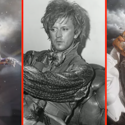






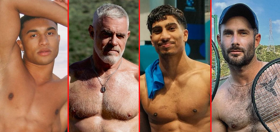







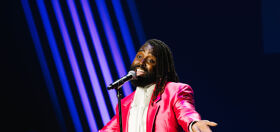
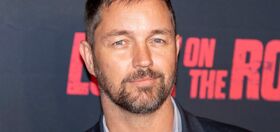
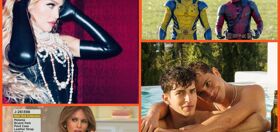
Lefty
Bayard Rustin ftw!! x
a.mcewen
Kudos on an excellent list. One thing though – a transgender should have been included. I say this because I did something like this last year and forgot to include that very important segment of our community.
Isaac C
All of these people are pretty much irrelevant in the grand scheme of things outside of racial/color representation, which I guess is important enough for some people. I certainly don’t consider most of them a part of the GLBT rights movement.
@a.mcewen: No, a transgender should not have been “included” just for the sake of it. Not now, not ever.
Tackle
@Lawrence Ferber: Nice article. But I wish you would have done your homework regarding the passage of Prop-8. What I take issue with is the wording (whether true or not.) This leaves OPEN the possibility that, (it JUST might be true). Leaving myths, un truths and out rights lies open and lingering. Nearly four years later.
Well it’s NOT true. Impissible by numbers.
I wish I can post the link here, but I can not. I’m at work on a work computer.
But anyone who wants to see the truth can type in: Driving Factors of Prop-8 vote
As I stated before on another thread:
Blacks make up 6.2% of the population of California. Whites:40.1% Hispanic/Latino:37.6%
Asian:13%… Blacks making up only 9% of the California electoral voters while voting at 58%, could not swing prop-8 either way.
The Black church going population is at 57% but only making up 6.2 of the Calif: population.
White church going population is at 42% but making up 40.1% of the Calif: Population.
Asian church going population is at 40% but making up 13.0 of the Calif: Population.
The Black church had NOTHING to do with Prop-8 passing. And lacked the funding like the other major churches. Mormon, Scientologist,Catholic,Evangelical Christians,Southern Baptist: ect… Who combined together exceeds the number of Black California church goers.
And something I left of my other thread regarding this matter, that 9% that Blacks make up as California voters is even lower. Because 9% would be 100% of thoese who are registered to vote. And whether your Black,White, Asian,Hispanic/Latino or other, NO group will turn out 100% in voting power.
The truth is, Whites made up 75-80 of the November-8 voters in California. However I’m not saying lets blame Whites. Lets take race out, and blame on the voters who passed prop-8. Regardless of color.
Isaac C
@Tackle: What black apologists (and anti-white racists) like you fail to realize (consistently) is that it doesn’t matter whether or not blacks caused Prop 8 to pass. It’s pretty clear that blacks played little to any substantial role in it passing.
But the *fact* that they overwhelmingly voted for Prop 8 is the real issue and what people have and will continue to take issue with. You can post as many percentages and racial breakdowns as you like, but you can’t change the perception of the issue at its core: which is that American blacks are overwhelmingly anti-gay when it comes to many gay civil rights issues, like marriage equality.
Mike in Asheville
@a.mcewen: @Isaac C: And what of Rupaul? Not my personal cup of tea, nonetheless, Rupaul is way out there and is playing a large role in fighting homophobia/transphobia.
RLS
Such a great list, and kudos to queerty for compiling it. All these people are heroes in their own right.
Now all I ask is maybe a bit more positive coverage (or coverage at all) of black LGBT people during the other 11 months of the year.
Mike in Asheville
@Isaac C: No, the problem is that racists and blame-gamers find the black community an easy target. You propagate that by calling “fact” that the black community [your word] overwhelmingly voted for Prop 8, when the real fact is that the black community MARGINALLY voted for Prop 8, just like every other group than gays/lesbians.
A total of 13.4 million Californians voted on Prop 8; 6.2% African-Americans, or, approximately 830,000. Of those votes, the breakdown is approximately:
482,000 African-Americans voted FOR Prop 8
348,000 African-Americans voted AGAINST Prop 8
That means 466,000 more white/Asian/Hispanic voted for Prop 8 than voted against, or three times the number of black votes for Prop 8.
Mike in Asheville
@Lawrence Ferber: I would add Alvin Ailey to your list. While not overtly an activist, his company performed around the country, and during those very sad days of AIDS deaths, performed for many AIDS charities. His influence in dance rivals any other American.
KyleW
RuPaul – “supermodel of the world”. Surely that’s something of an overstatement? Don’t think he has any profile outside the US How popular is he over there?
Liked his comment at the end though I hope that’s how he really thinks, and he wasn’t just trying to seem deep for an interview.
RLS
Don’t feed the trolls, ppl. They will come into any thread with a black person in it to stir something up…
Chitown Kev
Rupaul over Sylvester?
Puh-LEASE.
wisdomteachesme
I love this! Thank you!
Though I am saddened that Audre Lorde is Not included.
There Is No Doubt that she CREATED open paths for us all to walk upon.
Hopefully you will create a Part 2 and Include her.
*note* your title says 7, but you have 8 bios.
Icarus DaSun
@Isaac C: Umm, anti-white racists? I’m sorry, but I have to disagree. There’s no such thing as anti-white racism. Racism is not solely about likes or dislikes, racism occurs when there is power involved. When someone makes a racist comment or acts on their racist ideals, it will take power away from a community and force them to question how far we’ve really come as a society. You can’t do that to a white person, they’ve been birthed and bathed in privilege and power, they never have to face oppression, prejudice, or irrational hate that will stifle some part of their lives. They don’t have to wonder how far society has come because they’ve only ever been told that they’re on top. There’s no such thing as “reverse racism” or “anti-white racism”, maybe you should think about that one.
Just so you’re aware, I am white, I understand the power and privilege that I’ve been granted by North American society, and I understand the responsibility that comes with to defuse the ignorance and bigotry of people who may listen to me over a person of color. I am an ally, I am Queer, and I am fighting for not only my own rights, but the rights of those who need a helping hand.
Joetx
Leave it to Isaac C & his ilk to chime in w/ their racist comments on Queerty.
Dude Srsly?
@Isaac C:
So it’s a problem that ”the core of American blacks” are anti-gay, but ”American whites” that are anti-gay are excused?
You’re no better than any of the colors, or nationalities that hate you, because of your sexuality. Don’t even think your better off than any colored person, because the moment people know of your sexuality, you’ll be treated differently.
Do you think that homophobia is race bound issue and that the acceptance of ones’ sexuality only lies within the white community. If it were, than you would have probably already had the chance to marry in every state, in the US, as the majority of the US is white. How’s that going?
I don’t know what you have against black people, but being anti-gay/not wanting equality does not have a specific color. You should realize that.
Mike UK
you all should just really ignore what Isaac C has to say, he finds fault with everything and everyone! most of the time he talks out of his arse, the rest of the time he talks total bollocks! I’m convinced that him and Jason are roommates!
David Aventura
Don Lemon? Really? How do you lump Lemon in the same category as Rustin?
Mike in Asheville
@Chitown Kev: And I kissed him!
Following my first SF Pride (1981), my college boyfriend and I, and friends, grabbed BART for our first pride parade. Following the parade and festival, we headed to the I-Beam for their after parade tea dance. Lo and behold, Sylvester was the live act! The heavy beat, the shirtless boys/men, a day of celebrating, and then Sylvester covers “I Am What I Am” and its one big dance-and-sing along. During the transition to another song, I climbed on stage, planted a big old kiss with Sylvester, and back to the dance floor — a night I love remembering.
Dr. Tim Riley
The late great Barbara Jordan!!! She should have been our president!!! I miss her so much!!!
Marcus
For black history month the list should have more black people on there who love there blackness not some many white washed uncle toms.
JayKay
@Icarus DaSun:
You’re pathetic, and everything that’s wrong with the modern white male. A typical, sad, self-hating, brainwashed little liberal.
Racism is racism. And whites are very often the victims of it.
Just because your intro to Afro-American Wymyn’s Studies 101 professor taught you that imaginary definition of the word “racism” doesn’t make it true.
Isaac C
@JayKay: I totally agree.
@Marcus: LOL.
Halston
@JayKay: Well, racism may be racism but American whites have never suffered intstutionalized oppression. There is also Heterophobia as well -I see it in some of the irrational comments of this site everyday.
Chitown Kev
@Dr. Tim Riley:
Yes but look at the headline…
I loves me some Barbara Jordan too but throughout the time that she was a rep., she was closeted and not a face of gay America that most Americans would have recognized.
At least the way I read this headline, Jordan wouldn’t be an exact fit (Little Richard may or may not be the best musical fit)
Shannon1981
Great list. I am especially proud of Don Lemon for coming out. I feel like he risked a lot there.
I realize that some people might take issue with RuPaul being included, due to the fact that the whole famous drag queen thing ups the ante on promoting stereotypes…but it takes a whole lot of balls to be known as a guy in a dress your entire life.
Skrim
Note to the editor: Please spell Audre Lorde’s name correctly. There is an ‘e’ at the end. Thanks.
Dude Srsly?
@JayKay:
It’s good to know that you atleast see racism as racism and not as something as idiotic as anti-white racism.
Too bad your probably part of the problem, even though you’re a minority yourself.
Charlie
@Isaac C: Irrelevant? Bayard Rustin is irrelevant? What?
Oy, so we get a very lovely list of African American gay folks who made a difference and in the comments we have this ugliness about who voted or didn’t vote for Prop 8. I have never seen anyone demand an apology from the senior citizen community despite the fact that they overwhelmingly voted for Prop 8.
Phil Cory
Scott G. Brown, aka Gene Brown is the oldest African American survival of the Stonewall Inn raid of June 28, 1969. At the age of 70, he re-visited the Stonewall Inn on Christopher in Greenwich Village to honor the 42nd Anniversary of the raid. His book tells of the event, and he was invited by American Experience and PBS to tell his story during the Stonewall Uprising last April. He should be added to the list.
perdeep
If Isaac C isn’t Jason’s split personality (possibly along with JayKay), I will eat my hat.
On a less tangential note, I’m proud to support Black History Month despite not being Black, just as I know many Black people support Pride despite not being queer. There’s a pattern of oppression and if we’re smart we’ll make allies amongst ourselves. People who are homophobic are usually also racist, sexist, and classist, because at the end of the day it’s all about POWER. If we let the powerful people turn us against each other, we’ll never get equality.
Mike in Asheville
@perdeep: I, for one, certainly agree with your sentiment regarding Isaac/Jason/JayKay. But I will point out, they must be different folk as Isaac does not blame that the existence of women as the root of all evil.
BTW, there are 2 Jasons who regularly post here; the misogynist one goes by “jason” all lower case while the sane one uses the regular Jason.
Michael Bedwell
1. Bayard Rustin is one of my most beloved heroes, but even though he does fit in the list because of those many whose eyes he opened who KNEW he was gay, your chronology is wrong. Far from the 1970s, only in the last couple of years before his death in 1987 did Rustin come out “publicly,” and do some speaking and writing about homophobia, and lobbying for New York City’s gay rights bill. In fact, a year before he died, Rustin rejected your label himself, declining an invitation to contribute to an anthology by black gay men: “After much thought, I have decided that I must decline….I did not ‘come out of the closet’ voluntarily—circumstances forced me out. While I have no problem with being publicly identified as homosexual, it would be dishonest of me to present myself as one who was in the forefront of the struggle for gay rights. The credit for that belongs to others. They are the ones who should be in your book. While I support full equality, under the law, for homosexuals, I fundamentally consider sexual orientation to be a private matter. As such it has not be a factor which has greatly influenced my role as an activist.” – from “Lost Prophet, The Life and Times of Bayard Rustin” by John D’Emilio.
2. A MAJOR figure missing is Gil Gerald who, among his other accomplishments, in 1983, as executive director of the then-National Coalition of Black Gays, was one of *two people who convinced Coretta Scott King to finally abandon her hesitance in speaking about gay rights. The turning point was the refusal by Cong. Walter Fauntroy, chair of the committee for the 20th anniversary celebration of the 1963 March on Washington, to allow any gay person to speak at the rally following the new march. After an impassionaed conference call with Mrs. King and others, and a sit-in and arrests at Fauntroy’s office, Mrs. King was persuaded to publicly, fully embrace gay equality for the first time, and black lesbian poet/activist Audre Lorde was chosen to represent our multicolor community on stage, and gays were explicitly invited to participate in subsequent 1963 March anniversary observances. [*The other was then-National Gay Task Force chair Ginny Apuzzo.]
3. Another major player missing is Perry Watkins, the first gay service member returned to the military by court order. He also got a Circuit Court ruling that the ban was unconstitutional decades before the District Court ruling in the Log Cabin case. His several-years long fight with the military is described here:
https://www.facebook.com/profile.php?id=1822575019#!/note.php?note_id=232590153456267
Thank you.
Mike in Asheville
@Michael Bedwell: Reading your comment reminds me of another missed hero, James Baldwin. A major participant in the 1950/60s civil rights movement, Baldwin’s writing went beyond the politics of race and included the politics of sexuality.
Isaac C
@Charlie: Tackle is a militant, anti-white racist black commenter and he is the one who brought up Prop 8 because he took issue with the topic in the story. He happens to do that in pretty much every story or comment that even alludes to the way blacks voted in Prop 8. Your issues should be with him.
As for Bayard Rustin, it’s clear that he was a black man before anything else, and that’s where his loyalty was. Being gay was an afterthought for him and he probably felt ashamed of it his whole life, as Michael Bedwell more or less pointed out. But go on, celebrate the closeted queen if you must simply because he is black. That’s what this month is for after all, isn’t it?
Joetx
@perdeep: +1
J
@Isaac C: I’m starting to think you really are a straight up racist. I’m black so allow me to apologize for being born with brown skin. Whoever hurt you in your past really did a number on you but you need to grow up and get over it. Spewing hate is a poor coping method.
Michael Bedwell
@Isaac C:
I can’t let stand your misinterpretation of what I wrote about Bayard Rustin. I never suggested that he was ashamed of being gay, nor do I believe he was. I can think of no man so great who suffered so much for being gay throughout his life…..and, functionally still does a quarter-century after his death. For had he not been pushed down again and again simply because he was gay, including by MLK himself, his name would likely be as familiar to those of all colors throughout the world as King’s. His reticence is something I regret, but would never condemn.
Isaac C
@Michael Bedwell: I apologize if I distorted what you wrote. I didn’t mean to. That was my own opinion and take away from your post.
@J: I really have no clue what you’re talking about.
Dude Srsly?
@Isaac C:
You are seriously messed up, with that kind of thinking process.
I don’t really know a lot about the gay community, but I sure hope that only a few people like you exist and that I will never ever meet someone as awful as you.
Although I’d rather have people like you not exist at all, since life would be a lot easier =D.
Isaac C
@Dude Srsly?: LOL.
Nancy Kates
(This is primarily in response to Mr. Bedwell:)It’s great to see these figures being recognized, and to see people engaging in discussions about Bayard Rustin. I think there is a danger in imposing the yardsticks of 2012 on the historical past, however. Bayard Rusting was out in the movements he worked in, and to his friends, starting in the 1940s. The fact that he was publicly humiliated in 1953 after being arrested on what the Pasadena police of that era called a “morals charge” meant that he came out in 1953, not in the 80s. Yes, it is true that it was not by his own choosing, but given that it was almost 60 years ago, I think he has to be seen as a pioneer in this arena. Quoting from John D’Emilio’s book without the proper historical context is a bit misleading.
Nancy Kates, Producer-Director, Brother Outsider: the Life of Bayard Rustin
Interesting
First happy to see this list. The list is actually much longer, but this is a good start. Rustin is a personal hero for so many reasons.
@perdeep: I keep saying that I think Jason, Issac and the other are just sock puppets of one another. I doubt there are many people who think like that in reality.
@Shannon1981: If you want to understand my problems with Isaac C, you need look no further than this thread. I have no problem with people who differ with me on racial issues. I have a problem where every time it comes up, it becomes an excuse for vitriol and hijacking a comment section. I believe its Jason- or whoever- for example, who has problem with women and bisexuals, and every time he posts its the same shit. The same is true of Isaac C and race. Jason used to do that as well.
Interesting
@perdeep: A Haitian American friend said when the Prop8 ruling came down, “Don’t they [people of color supporting the action] get this shit is going to come back to bite us all in the ass” So, yes, its all one movement – toward human rights.
Interesting
@Mike in Asheville: There was a Jason who used to post here with racially antagonistic posts last year. Who knows if its the same one. I do think its the same kind. But that’s in part because I find it ahrd to believe there are that many people that dedicated to this sort of racial hatred.
Isaac C
@Interesting: NOW who’s stalking who? LOL.
The only anti-white racist is you and always has been you. You’re just too much of a coward to come clean and admit what’s obvious to anyone who reads your posts. And why are you involving Shannon? She doesn’t have anything to do with what I wrote. Or are you still sore over the fact that you accused her of all kinds of terrible things because she refused to side with you on your black issues, and now you’re trying to “win” her back?
Pathetic. Get a life.
Tackle
@ Interesting: I don’t believe that Issac C is Jason. It’s not Jason wording or sentence structure. Or as someone else pointed out JayKay. But I do believe that Issac C is non other than Daniel Villarreal. The same words/wording. Same sentence structure, grammer and all. And a bitter dislike and resentment towards Black men.
When Queerty folded last year and Daniel came in, becoming lead writer. It seems his mission from the very start was to put negative after negative stories about Blacks. The last I counted, he did over 42 stories regarding Blacks. All with a racial slant. He made a deliberate attempt to push racial buttons, just like Issac C. And with a strange race obission with Black people.
A couple of months ago, Daniel advertised on here (Queerty) for writers. He got a slew of volunteer, unpaid writers. Since he has his volunteers, I guess he decided to take a break. He has other small writing gigs. Funny how this Issac C characture showes up when Daniel takes a break from Queerty. And when Daniel was writing for Queerty, and as racist as Daniel was/is, Issac C was no where to be found on any artical by Daniel. What better way for Daniel Villarreal to continue his race bating, and to show his dislike towards Blacks by hiding behind his persona Issac C.
Interesting
@Tackle: @Tackle: At the end of the day, it really does matter who it is. My advice at this point, which I am going to take myself, is to ignore him.
Isaac C
@Interesting: Thank GOODNESS. By far the most sensible thing you could do, for your own sake. And maybe this cheap Malcolm X knock-off Tackle will follow your example so I can have both of you hypocritical, whiny black racists off my arse.
Matt
How the fuck is Phill Wilson alive if he was showing signs of AIDS in 1981? Dude must have an insanely good immune system, proper treatment didn’t come along until 1996.
Chris
Queerty leaves out bisexuals as usual, they could have included these bisexual black men instead of media whores like Ru Paul, Don Lemon, and Wanda Sykes.
1977 – Alan Rockway, a psychologist and bisexual activist, co-authors the nation’s first successful gay rights ordinance put to public vote, in Dade County, Florida. When former Miss America and orange juice spokesperson, Anita Bryant, initiates her viciously homophobic “Save Our Children” campaign in response to the ordinance, Dr. Rockway conceives of and initiates a national “gaycott” of Florida orange juice. The Florida Citrus Commission cancels Ms. Bryant’s million dollar contract as a result of the “gaycott.”
1979 – A. Billy S. Jones, bisexual founding member of National Coalition of Black Lesbians and Gays, helps organize the first black gay delegation to meet with President Carter’s White House staff. Jones is also a core organizer of the 1979 March On Washington for Gay and Lesbian Rights.
Mike in Asheville
@Matt: For pretty much everything, there is a bell curve for HIV/AIDS life expectancy. Like Phil Wilson, I was most likely infected with HIV in 1980/81 and yet I am here; on the other hand, though, my cousin, the first born of our generation, died way back in 1986, less than a month after diagnosis.
There are quite a few of us around. I don’t want to get off subject — this is a great one. But I have to add, if you ask any of us, I can’t imagine any other longterm survivor would suggest that today HIV/AIDS is readily or easily treatable as other diseases are. Certainly medical care and treatment have come a long way to make things better, but pretty much anything is better than the quick horrible painful HIV/AIDS deaths in the 1980-90s.
There need to be many more Phil Wilsons out there sending that message to the African-American community.
Cheers to all these brave souls.
quinn
why say LGBT african americans when you only included LGB… not that these people aren’t inspirational or important, but i guess i should be used to the ‘T’ being ignored… great job queerty…
Matt
Quinn-I don’t see any bisexuals mentioned in this article, just gay men and lesbians. Then again a lot of gay men and lesbians wish the B & T were not around or as vocal as we are, and that we should just concentrate instead on only issues that effect gay men and lesbians.
Mike in Asheville
@quinn:@Matt:
And what of RuPaul?
And for the rest of us, please nominate the Bisexual African-American sexual orientation civil rights leaders that you admire so we can appreciate them too?
I nominated the inclusion of James Baldwin (weird Queertry used his pic but no article?) and Alvin Ailey while seconding ChiTown Kev’s nomination of the late great transsexual performer Sylvester.
So, who is missing from the Bi list?
uptownpapi
@Isaac C: LOL, gays like you are the main reason the word faggot is still in use.
Oh, ok.
I’ll try to remember this the next time I’m walking around West Hollywood getting scoffs, shuns, and glares from an overwhelming majority of the white gay men around here when they notice my brown skin in “their” neighborhood.
Because it will make everything “Get better”, right?
Isaac C
@Oh, ok.: Well, stay out of WeHo if you don’t want the “glares, shuns, and scoffs.” It’s interesting that you turn an article celebrating the achievements of gay people of color, during Black History month, into a space to whine about how white gay men won’t give you the time of day. Do you not see the irony?
Why are you so apparently desperate for white guys to dig you, anyway? That’s the question you should be asking yourself. You probably just don’t like yourself, that’s all.
Oh, ok.
The irony is you call it whining and think it’s no big deal. The irony is you don’t understand the fight for civil rights in this country. The irony is that you don’t see people like myself who put up with it and refuse to leave make things change.
Who said anything about wanting white guys to “dig” me, Fonzie? Is WeHo a whites only affair and I’m not allowed to talk to anyone who’s white?
Am I supposed to be ignoring them and never interact with them?
Are you really this stupid?
The IRONY is white gay men being racist, but you didn’t think of that…did you? Moron.
tj
Did someone say “black apologists”?????
LOL. That is actually the most hilariously racist thing I’ve ever heard. I’m hoping you’re just an idiot and don’t fully understand the term “apologist” or its usage. You can be a black apologist unless you’re using black in a pejorative sense.
Isaac C
@Oh, ok.: “Is WeHo a whites only affair and I’m not allowed to talk to anyone who’s white?”
Apparently so, since that’s all you seem to notice when you go there. You wouldn’t be making such a big deal about it if that wasn’t the case. Work that out. You’re like an open book.
And yes, stop whining, you dumb whore. No one cares that white dudes don’t want you or want to associate with you, and trying to fit that square peg into a discussion about civil rights is stupid.
Oh, ok.
@tj: Were you actually trying to say something in that tangle of rambling?
Oh, ok.
@Isaac C: LOL, thanks for the laugh, clown. You and your cat must be very happy together. LMFAO!
Isaac C
@Oh, ok.: I figured you wouldn’t have anything else to say. Your kind is always like that in the end, making a big stink about white gays and then leaving.
Oh, ok.
@Isaac C: What’s my kind? What would you like me to say?
“Leaving”? It’s a comment box on an internet site. You would know that if you went outside. That’s how I know you’re a cat loving, shut in, with no life. That’s why I’m laughing at you.
Wake up, dude.
Michael Bedwell
@Nancy Kates: With great appreciation for your marvelous documentary about Bayard Rustin, I’m sorry but I see nothing in my original post to suggest that I was judging him by 2012 standards. Nota Bene: I explicitly wrote, “…he does fit in [Queerty’s] list because of those many whose eyes he opened who KNEW he was gay…” which was a reference to his friends and fellow movements [plural] with whom he worked over many decades as you commented—though your assertion that he “came out publicly” in 1953 through his arrest is a ridiculous redefinition of that term in this context, and “out” in those movements [in terms of having explicitly told/made self-obvious to everyone he was gay] only relatively true. And in a subsequent response to someone’s wrongly rephrasing what I wrote, I unequivocally stated that I could never condemn Rustin for the choices he made before 1985 related to his being gay. However, with all due respect, YOUR choosing to define Rustin differently than he defined HIMSELF [as I quoted] in response to an invitation to contribute to an anthology of writings by gay black men is extremely inappropriate.
Dude Srsly?
@Isaac C:
Yet you’re the one typing bullshit on a website, while you probably wouldn’t even dare to say anything like this in public.
Glad to see that you have balls on the internet. Try being a man in real life now.
Miss Kitteh
Seems like a pissing contest between the really insane racially obsessed white boy and any Black who’s written here. I happened upon Queerty.com because I was doing a search on some poor HIV+ guy whose co-workers McDental office sprayed him with lysol and otherwise harrassed him.
Why the fuck don’t you all get your shit together and simply ignore the trolls like the nut case who calls itself “Isaac C”? He’s apparently just really gone — and I do mean g-o-n-e — or he’s just another troll without a life.
Miss Kitteh
Seems like a pissing contest between the really insane racially obsessed white boy and any Black who’s written here. I happened upon Queerty.com because I was doing a search on some poor HIV+ guy whose co-workers McDental office sprayed him with Lysol and otherwise harassed him.
Why the fuck don’t you all get your shit together and simply ignore the trolls like the nut case who calls itself “Isaac C”? He’s apparently just really gone — and I do mean g-o-n-e — or he’s just another troll without a life.
Miss Kitteh
And, no, I won’t be coming back to have another look-see. Sheesh!
mickw
Based on Queerty Comment Policy, shouldn’t Isaac C be banned from commenting by now?
Oh, ok.
Queerty doesn’t ban for anti-black commentary.
tjr101
Isaac C obviously has a major chip in his shoulder when it comes to black people. It’s interesting how the usual suspects show up when it comes to topics about black people.
Karari Kue
Wow. Marsha P. Johnson is no where to be found on this list. A STONEWALL VETERAN. But we do have RuPaul. Not even Audre Lorde is on the list.
And then some wonder why Black History Month is needed.
Phil
Sylvester was not Trans, he didn’t want a sex change operation, refer to himself as a woman, or want to take hormones. He was just a black drag queen. Ru Paul is the same way, he’s not Trans at all.
Mike in Asheville
@Oh, ok.: The last time I hooked up in West Hollywood (2003) there were 4 very attractive black guys, 5 very attractive white guys, 1 the hottest of all Hispanic, and me somewhat exotic white (quarter each Hindu, Dutch, Hungarian, Welsh).
It was a very fun weekend; several times various combos would run out for food and such, never felt any weirdness from fellow gay passersby irrespective of who I was walking with.
My point, yes indeed there are plenty of racist gay guys; but there are also plenty of gay guys who are simply into men of all colors and flavors. Variety of a great sex spice, and extra spicy sex is yummy. They are there, right in West Hollywood, just be open to finding them.
Mike in Asheville
@Phil: Wow, what arrogance! So you, Phil, now decide who is who and what is what?
Trans or Transgender is the all inclusive term comprising all the various forms including transsexual, transvestite, drag and cross-dressing, and various hermaphrodites, and includes all sexual orientations. The “T” also includes the many straight husbands who, for enhanced sexual desires, dress in their wive’s clothing.
There is NO requirement to have, or even to desire, a sex change and neither is there any requirement or desire to self identify with any particular sexual identity. The unifying definition is that one does not conform to conventional sexual identity.
Certainly one could argue that Flip Wilson and Milton Berle were completely straight and used female costumes for entertainment purposes (at least in Berle’s case there is substantial Hollywood gossip that he was hung like a horse and fooled around with many ladies).
RuPaul and Sylvester though clearly embraced their transgender identity.
From OED (Oxford English Dictionary)
transgender (trans|gender)
Pronunciation: /trans?d??nd?, tr??ns-, -nz-/
(also transgendered /trans?d??nd?d, tr??ns-, -nz-/)
adjective
* denoting or relating to a person whose self-identity does not conform unambiguously to conventional notions of male or female gender.
Misty
@Isaac C: That’s the problem. We treat LGBT people of color as irrelevant and we only reach out to a limited group of people (middle class white people)
Misty
@Isaac C: What your racist ass ignores is that So did Mormons, Latino’s, catholics and others, and the black votes wasn’t big enough to get Prop 8 defeated. Not to mention the majority of the people speaking about the “homosexual agenda” like demagogues are white christian men (Tony Perkins, Pat Robertson, etc.) This racism and attitude towards people of color (specifically black people) by white gays is hurting the LGBT community. The ignoring the voices of LGBT POC is not bringing the groups together. If the gay community considers the gay rights movement a civil rights movement, the perspective of People of Color needs to be taken into order just as much as white folks. When all non-gay black folks see in gay magazines, PFLAG, and other gay media and gay organizations are almost exclusively white people and not showing strongly the diversity that is the LGBT community, can you blame some straight blacks for thinking that it’s a white person thing when there are quite a bit of LGBT organizations and media blogs not doing it’s part in reaching out to communities of color w/o being condescending towards blacks as a whole, including gay blacks?
Misty
@Charlie: Thank you. It was an effort of a lot of folks.